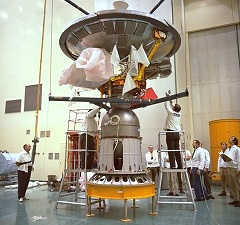I have been thinking about neutrinos today. No, not about faster-than-light neutrinos. I was skeptical about the sensational claim from the OPERA experiment last year, and my skepticism was well justified.
They may not be faster than light, but neutrinos are still very weird. Neutrinos of one flavor turn into another, a discovery that, to many a particle physicist, had to be almost as surprising as the possibility that neutrinos are superluminal.
The most straightfoward explanation for these neutrino oscillations is that neutrinos have mass. But herein lies a problem. We only ever observed left-handed neutrinos. This makes sense if neutrinos are massless particles that travel at the speed of light, since all observers agree on what left-handed means: the spin of the neutrino, projected along the direction of its motion, is always −1/2.
But now imagine neutrinos that are massive and travel slower than the speed of light. As a matter of fact, imagine a bunch of neutrinos fired by CERN in Geneva in the direction of Gran Sasso, Italy. It takes roughly 2 ms for them to arrive. Now if you can run very, very, very fast (say, you’re the Flash, the comic book superhero) you may be able to outrun the bunch. Looking back, you will see… a bunch of neutrinos with a velocity vector pointing backwards (they’re slower than you, which means they’ll appear to be moving backwards from your perspective) so projecting their spin along the direction of motion, you get +1/2. In other words, you’re observing right-handed neutrinos.
This is just weird. On the surface of it, it means that our fast-running Flash sees the laws of physics change! This is in deep contradiction with the laws of special relativity, Lorentz invariance and all that.
How we can interpret this situation depends on whether we believe that neutrinos are “Dirac” or “Majorana”. Neutrinos are fermions, and fermions are represented by spinor fields. A spinor field has four components: these correspond, in a sense, to a left-handed and a right-handed particle and their respective antiparticles. So if a particle only exists as a left-handed particle, only two of the four components remain; the other two (at least in the so-called Weyl representation) disappear, are “projected out”, to use a nasty colloquialism.
But we just said that if neutrinos are massive, it no longer makes sense of talking about strictly left-handed neutrinos; to the Flash, those neutrinos may appear right-handed. So both left- and right-handed neutrino states exist. Are they mathematically independent? Because if they are, neutrinos are represented by a full 4-component “Dirac” spinor. But there is a possibility that the components are not independent: in effect, this means that the neutrino is its own antiparticle. Such states can be represented by a two-component “Majorana” spinor.
The difference between these two types of neutrinos is not just theoretical. The neutrino carries something very real: the lepton number, in essence the “electronness” (without the electric charge) of an electron. If a neutrino is its own antiparticle, the two can annihilate one another, and two units of “electronness” vanish. Lepton number is not conserved.
If this is indeed the case, it can be observed. The so-called neutrinoless double beta decay is a hypothetical form of radioactive decay in which an isotope that is known to decay by emitting two electrons simultaneously (e.g., potassium-48 or uranium-238) does so without emitting the corresponding neutrinos (because these annihilate each other without going anywhere). Unfortunately, given that neutrinos don’t like to do much interacting to begin with, the probability of a neutrinoless decay occurring at any given time is very small. Still, it is observable in principle, and if observed, it would indicate unambiguously that neutrinos are Majorana spinors. (A prospect that may be appealing insofar as neutrinos are concerned, but I find it nonetheless deeply disturbing that such a fundamental property of a basic building block of matter may turn out to be ephemeral.)
Either way, I remain at a loss when I think about the handedness of neutrinos. If neutrinos are Dirac neutrinos, one may postulate right-handed neutrinos that do not interact the way left-handed neutrinos do (i.e., do not participate in the weak interaction, being so-called sterile neutrinos instead). Cool, but what about our friend, the Flash? Suppose he is observing the same thing we’re observing, a neutrino in the OPERA bunch interacting with something. But from his perspective, that neutrino is a right-handed neutrino that is not allowed to participate in such an interaction!
Or suppose that neutrinos are Majorana spinors, and right-handed neutrinos are simply much (VERY much) heavier, which is why they have not been observed yet (this is the so-called seesaw mechanism). The theory allows us to construct such as mass matrix, but once again having the Flash around leads to trouble: he will observe ordinary “light” neutrinos as right-handed ones!
Perhaps these are just apparent contradictions. In fact, I am pretty sure that that’s what they are, since all this follows from writing down a theory in the form of a Lagrangian density that is manifestly Lorentz (and Poincaré) invariant, hence the physics does not become broken for the Flash. It will just turn weird. But how weird is too weird?





 Having been told by a friend that suddenly, there is a
Having been told by a friend that suddenly, there is a 